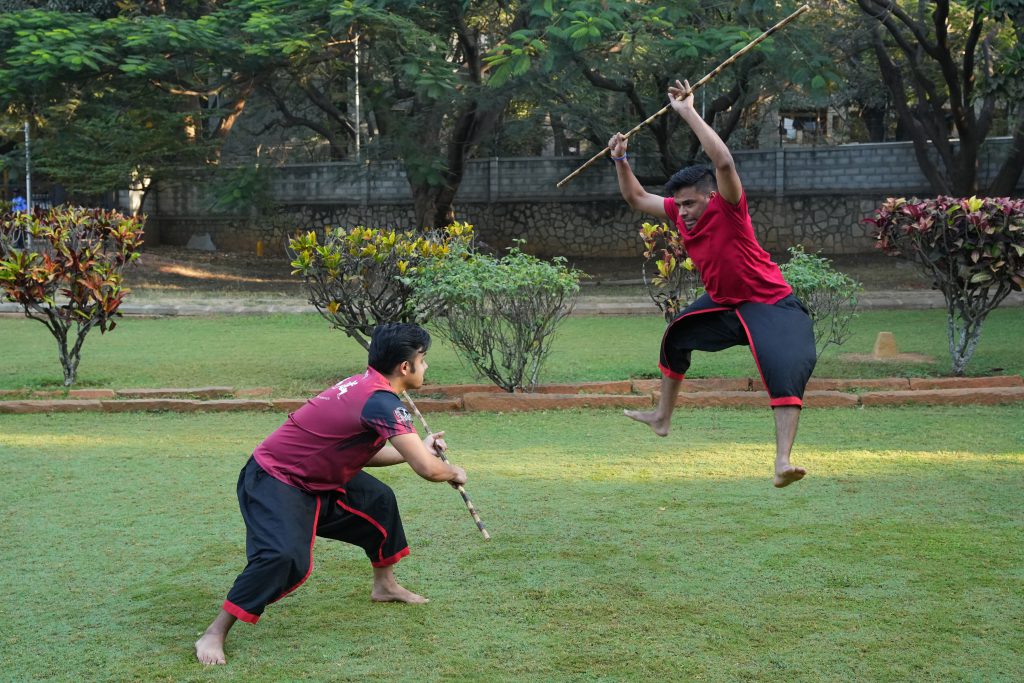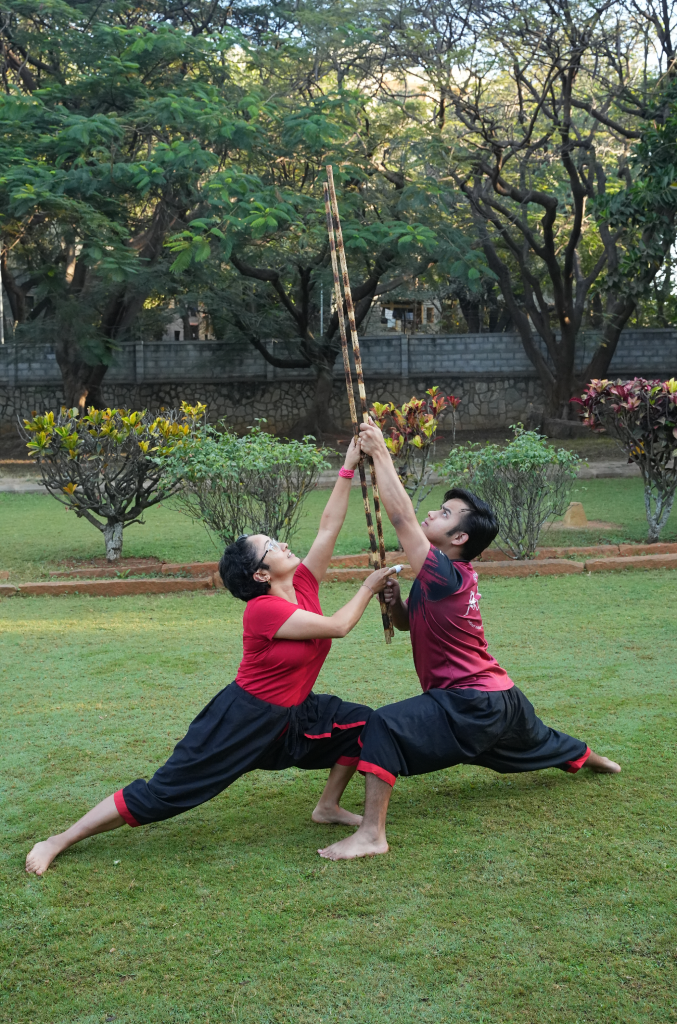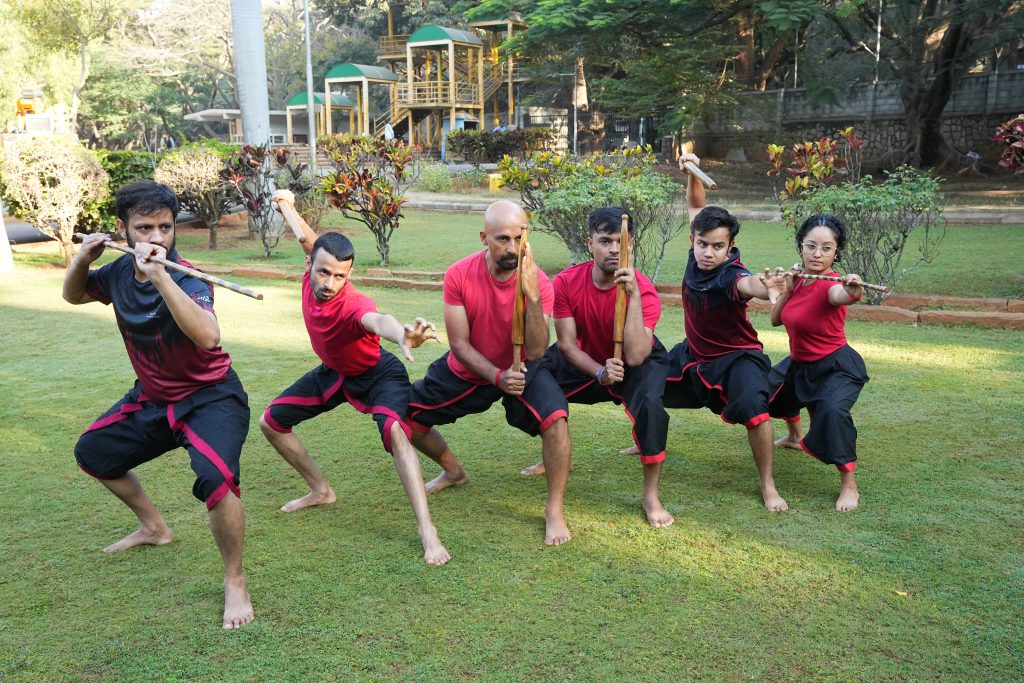Kalari club nurtures the cultural practice on campus

It was the inaugural event of Rhapsody, an annual fest of IISc, in July 2023. The JN Tata auditorium was packed with an ecstatic audience looking forward to a cultural extravaganza. Draped in red-and-black costumes, resembling ancient warriors, the members of the IISc Kalaripayattu club marched onto the stage to loud cheers. Tailing them were drum and trumpet players who settled into a corner on the stage, blending into the shadows. Agile and focused, the performers started with a series of body-warm-up movements involving bending, stretching and kicking exercises. This was followed by a Namaskara, a greeting to the sun and salutation to mother nature, intended to calm the body and enhance concentration and flexibility. The crowd went silent, waiting with bated breath for the show to begin. Demonstrations of swift, precise movements started, as they challenged each other with long sticks, spears, swords and shields, in a beautifully choreographed sequence of daring acrobatics. We watched, mesmerised, as the performers matched each other’s moves by bending, buckling, crouching and leaping, in a display of composure, balance and dexterity. The whole crowd was clapping and cheering in sync to the rhythm of drums and the trumpet (called didgeridoo). Finally, the performance ended with a resounding standing ovation.
The performance was graceful, like poetry in motion. It was the first time I was exposed to Kalaripayattu, the ancient martial art that was once a lethal form of combat warfare.

Kalari club at IISc
Kalaripayattu or Kalari, which originated in Kerala, is considered one of the oldest martial art forms. In its crudest form, it is believed to be a way of hunting wild animals which was eventually refined into a systematic combat technique to overpower enemies and defend oneself. Kalari aims to understand and balance the harmony between the body’s elements, leading to overall well-being with enhanced combat skills, self-discipline, humility and respect for opponents. At IISc, the Kalari club was started in December 2018. “Before that, Jaideep Joshi, a PhD student, used to go to Guruji Sudarshan Sampath [in Malleswaram] for Kalari practice and he, along with Sudhanshu Rathore, former club convenor, initiated the club. They wanted to introduce this art form to IISc,” says Smriti Basnett, the Deputy Director of the South Asia hub of the Future Earth Programme at the Divecha Centre for Climate Change.
Guruji Sudarshan has been practising Kalari for more than 20 years. He holds a world record for performing non-stop Kalaripayattu for 90 minutes straight in 2019 at the age of 45 years, to bring awareness about this ancient martial art form. “Ten minutes of our performance takes a lot of effort. Sometimes, I want to just get done with it. Ninety minutes is a lot,” says Mehul Kumar, in admiration. Mehul is the current convener of the club and a PhD student at the Department of Chemical Engineering. He was always interested in martial arts from childhood. “I was in the fourth or fifth standard when I started learning Judo. Then I stopped. I got the opportunity again when I came to know about this Kalari club through an email in 2020, after COVID-19. I joined the club and have stayed on till now.”
Divakar Badal, an alumnus of IISc and Protik Paul, PhD student in the Department of Computer Science and Automation were the past conveners of this club. Both of them also got to know about the club via an email. “The idea was we would learn something different from what we were doing in everyday life, like doing lab experiments, running from one lab to the other or to the mess or to the hostel,” says Divakar. “And it turned out to be really interesting. You didn’t need any tools, you didn’t need any heavy equipment. You just needed to be present there. Our bodies have the capability to give us the strength and power to change the way we think about ourselves. Kalari was helpful and we could be more productive in the laboratories as well,” he adds excitedly.
“We would learn something different from what we were doing in everyday life, like running from one lab to the other or to the mess or to the hostel”
Protik further adds, “Our Guruji is a very humble person and teaches so passionately. The classes always gave us so much extra energy which otherwise we didn’t feel we had. And it’s always nice to do these things, other than continuous lab work.”
Smriti joined the second batch of Kalari club and has been a member since then. “I did see that my posture was getting spoiled [by] working too much on the computer. I always wanted to follow some traditional form of movement and I don’t like static sports,” she says. She has always been interested in badminton and table tennis and has played in national tournaments as well. But Kalari, she says, is unique. “When I used to play table tennis or badminton, it was only like the right side of my body working. I needed a warm-up for intense playing or I used to get injuries. But Kalaripayattu has slow warm-ups and slow cooling. It’s so beautiful and rhythmic where you use a lot of your muscles, your energy and a lot of your breathing techniques. I am happy I joined it,” adds Smriti.
Training the body and mind
Kalari is a highly physical and energetic art form. It requires plenty of training sessions that are divided mainly into three levels, each level building upon the previous one. It starts with Meithari (basic physical conditioning) having rigorous exercises including yogasanas and breathing techniques intended to develop flexibility and strength. The intense physical training prepares the body for the advanced stages.
Kolthari or stick fighting teaches the art of combat using wooden sticks. Ankathari provides training in unarmed combat techniques including strikes, kicks and grappling. Techniques learnt in Kolthari form the basis for advanced weapon training and those learnt during Ankathari focus on self-defence and healing.

splits and animal poses (Photo: KG Haridasan)
The Kalari club has two classes per week, one taught by Guruji and the other by Mehul. The remaining days of the week are for practice sessions early in the morning. Divakar and Protik describe a typical session. “It’s early morning, the sun is there, just rising above the skyline. At that time, you have to wake up from the hostel and go all the way to the Gymkhana. It’s definitely challenging. But as the exercises start, our body slowly becomes active. Guruji always advises to have the sessions in the morning rather than in the evening. It’s better because we mostly work all day and night. Early morning sessions are more beneficial to the body as well,” says Divakar.
A significant amount of time is spent on warm-up sessions. “It started with Surya Namaskar, moving on to different body movements like rotating our hands in clockwise and anti-clockwise directions. Then came different types of kicks – straight, round and sidekicks – and a combination of kicks and splits. Then we would have a session with a combination of eight animal poses starting with the wild boar, then elephant, cat, lion, horse, snake, rooster and finally ending with a peacock stance. The routine ended with a few stretching exercises and meditation,” explains Protik.
“It’s a beautiful experience. It’s good to know how much our body can extend irrespective of our age”
The first weeks of training are always a challenge for a new student. “During the first few weeks after joining, I couldn’t even lift my leg, even though I play other sports extensively. When we did the kicks, it affected the muscles between the ribs. I could feel that. When I was resting or sleeping, I could literally feel the change in the rhythm of my breathing. While doing Kalaripayattu, we practised with a lot of exhalation. With each kick, we exhaled from the stomach. The exhales were, in fact, the counts. This was very fascinating,” recalls Smriti. “During the classes, we might feel tired, giving our 50%, but when Guruji comes, it’s like 200% energy. We might need to rest for the next two days. But that’s a beautiful experience. It’s just good to know how much our body can extend irrespective of our age.”
A wide range of weapons are also used in Kalari, like a single-edged curved sword called Vaal for both defence and offence, Kedahom (shield) for blocking attacks and protecting the body, Urumi resembling a whip with a flexible metal blade, Kuntham (spear) for long-range attacks, Kuttuvaal (dagger) for close combat and Kettukari (long wooden staff) for training and sparring. Each weapon requires agility and finesse for effective wielding, with the intention rooted in self-defence rather than offensive aggression.
A growing club
The group has been performing Kalaripayattu at several events both inside and outside IISc. They have performed outside IISc at events like Onam celebrations and the Kannada Film Festival. They have showcased Kalari at the G20 summit in Hyderabad too, where Guruji was invited to perform.
The performances are usually accompanied by the rhythmic music of drums and didgeridoo, which forms a major component of the art form.
Divakar explains, “The idea of Kalari is inspired from nature itself. If you are sitting peacefully in a forest, you can hear sounds of a river flowing nearby or rustling of leaves. The background music tries to mimic a natural sound.” Mehul further says, “The audience needs to connect with what we are presenting. Music binds the whole art.” “Performing with the music just takes you to another level. It’s like an addiction, you want to feel that again,” adds Smriti.

The group hasn’t participated in competitions so far. “I haven’t given a thought about participating in a Kalari championship. I’m mostly interested in performances. For championships, you need to be very focused and practice regularly. If I get the opportunity then it depends on whether I’m able to invest that much amount of time, keeping my PhD work in mind,” says Mehul.
The membership of IISc’s Kalaripayattu club changes each semester. They send out emails inviting students to join during every new academic session. There are usually a lot of registrations for the Kalaripayattu club in the beginning. Mehul says that most of them are PhD and MTech students. MTech students are here for only two years, with the last year mostly occupied with their projects and interviews for company placements.
In order to study and promote this art form, a fellowship has been instituted with a stipend of Rs 50,000 per month and an annual research grant of Rs 1 lakh. It is a joint initiative by the National Institute of Advanced Studies (NIAS), a sister institute of IISc, and UL Research Center in Kozhikode, Kerala. This is part of a research project on ‘Kalaripayattu and well-being’ which aims to scientifically study the different traditional Kalari practices and their effect on personal health and well-being.
“When I went to conferences, I was fascinated that some of the foreigners also knew what Kalaripayattu is and in India, it was equally surprising that many didn’t know about it. I feel Kalaripayattu should have more advocacy and publicity, which it hasn’t seen so far. Even in IISc, the other clubs are very active and very regular, but in Kalaripayattu I find a lot of dips and peaks,” reflects Smriti. “We also have plans to promote the club more. We are working on updating the webpage as well. Maybe with the new batches, we will resume this full-fledged again.” The membership of IISc’s Kalaripayattu club changes each semester. They send out emails inviting students to join during every new academic session. There are usually a lot of registrations for the Kalaripayattu club in the beginning. Mehul says that most of them are PhD and MTech students. MTech students are here for only two years, with the last year mostly occupied with their projects and interviews for company placements.
Surabhi Chandra is a second year PhD student at the Department of Developmental Biology and Genetics, IISc, and a science writing intern at the Office of Communications




